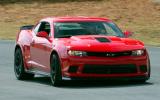What is it?
The Chevrolet Camaro Z/28. It’s an iconic badge in the American muscle car world, tracing its roots back to late 1966. Chevrolet needed a homologation special to battle the Ford Mustang on the race tracks of North America. Behind the wheel of Camaro Z/28, the great Mark Donahue helped Chevrolet win the SCCA Trans-Am championship in 1968 and 1969. He stood on the top step of the podium ten times in 1968.
The Z/28 carried on in various forms until 2002, when the Chevrolet Camaro was shelved. Then, in 2009, Chevy revived the legendary Camaro. Five years later, the Z/28 finally returns to North American roads.
As was the focus at inception, the latest Z/28 is very much a track oriented car. Think along the same lines as Porsche’s 911 GT3 RS. Chevrolet pulled the standard air conditioning system, removing 13kg. Thinner rear glass saves 400g. The 19-inch wheel and tyre package is 22kg lighter, despite massive 305mm Pirelli P Zero Trofeo R track tyres fitted at all four corners.
The giant carbon ceramic brakes save nearly 10kg and are shared with the upcoming C7 Corvette Z06. A glorious (and thirsty) 7.0-litre V8 engine from the C6 Corvette Z06 is found under the bonnet. The LS7 engine features a dry-sump oil system and puts out 505bhp. Helping put the power down is a Torsen limited-slip differential.
Elsewhere Chevrolet’s engineers have added extras, including a 'Fly Car Mode', which came about as the car kept getting airborne airborne at the Nürburgring, and was programmed using data from the ride-height sensors. As a result, engine power isn’t trimmed when the Z/28 leaves the ground.
What's it like?
A seriously quick car, and on the circuit all those modifications and tweaks come together. The big Z/28 coupé kept pace with a well-driven Porsche 911 GT3 RS 4.0 around Grattan Raceway, a challenging 2.0-mile track in western Michigan. The naturally aspirated V8 engine sounds amazing and has excellent torque, yet still screams to the 7000rpm redline like an engine half its size. Specal trick Multimatic dampers are very impressive at controlling the Z/28’s ride, but there is only so much you can do to hide 1732kg.
And therein lies the fundamental flaw in the Z/28; it’s just too damn heavy. In low-speed corners and quick transitions, the Z/28 isn’t remotely slow but the bulk can be frustrating. The precise but rather lifeless steering, heavy transmission, less-than-brilliant brake feel, and poor pedal placement only add to this. It’s a very fast car around a circuit and it does exactly what Chevy designed to do, but it’s a bit of a bull in a china shop. It ultimately lacks the precision and tactile feel of lighter track-focused cars.
The Z/28 reminds us that GM’s Zeta platform is starting to show its age. Sure, the updated Zeta underpinnings in the Vauxhall VXR8 saloon are impressive on the road but it’s not a proper track car.
Should I buy one?
Despite the negatives, the Z/28 carries a welcomed and honest muscle car feel. Plus, it still offers the increasingly endangered manual gearbox. But so does the 25 per cent cheaper, 15 per cent more powerful and far more street-friendly supercharged Camaro ZL1. Sure, the Z/28 is faster at the track but it’s tough to pay Porsche Cayman GTS money for the second-best Camaro in Chevy’s lineup, even with the rich history of the badge.

























Join the debate
Add your comment
NO WEIGHT PROBLEM AT ALL.
Should I buy one?
Praise one that deserves it